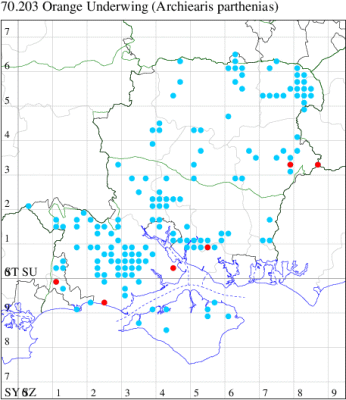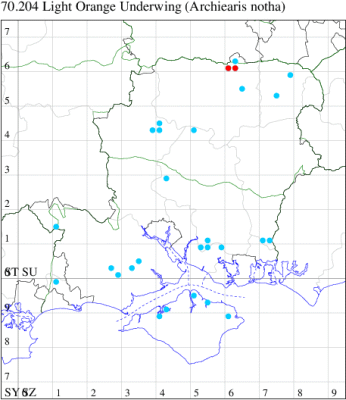2021 Annual Report for: Geometridae / Archiearinae
For species seen in 2021 that had less than or equal to 100 records, full details are included; for more common species, the earliest, latest and highest count by vice-county are shown. The narrative for each species is taken from the main Hantsmoths website, and it is possible that some information on abundance and occurrence can get out of date, as it is impossible to keep up with all changes; however it should give a good introduction to each species. The tables in each species account summarise the previous status, and that for the current year.
For the maps, all records prior to 2021 are shown by a blue dot (the larger the dot, the more recent), with the current year's records shown in red. As previous records are superimposed on any report for 2021, new sites have greater emphasis (i.e. will show as 'more red').
In the species accounts, an asterisk next to a location indicates a new 10km square record; earliest ever dates are highlighted in orange, and latest ever in red. Initials in the species accounts refer to the recorders listed here. Please get in touch if you identify any omissions or errors, in particular if you have records that have yet to be submitted. Details of how to submit records can be found here.
70.203 [B&F: 1661] Orange Underwing Archiearis parthenias (Linnaeus, 1761) - Local
Local in open woodland, scrubby heathland, embankments, and other rough open ground throughout much of the British Isles. In Hampshire and on the Isle of Wight has declined or disappeared altogether in many areas due to destruction of its birch woodland habitat and most often seen now in the New Forest and the north-east. Wingspan 35-39 mm. A diurnal flyer, seen in warm spring sunshine, often high amongst the branches but occasionally seen well on the ground - it seems to have an attraction to horse dung. They should be netted for examination: those netted are invariably males. Very similar to Light Orange Underwing B. notha, males can be distinguished by their antennae which are finely serrated in Orange Underwing, and are slightly feathered in Light Orange Underwing; on underside of hindwing of Orange Underwing, orange band projects centrally into dark outer band, often reaching outer margin, while in Light Orange Underwing, dark outer band is unbroken, and central projection of orange band is absent (MBGBI Vol 7 part 2). Larva feeds on Downy and Silver Birch, over-wintering as a pupa.
Records prior to 2021
| Vice County | #Records | #Individuals | First Record | Last Record |
|---|---|---|---|---|
| 10 | 20 | 9 | 1947 | 2019 |
| 11 | 251 | 282 | 1945 | 2019 |
| 12 | 168 | 237 | 1951 | 2020 |
2021 records
| Vice County | #Records | #Individuals | Max Quantity |
|---|---|---|---|
| 11 | 5 | 6 | 2 |
| 12 | 2 | 2 | 1 |

Records by year
Records by week (adult)
Records by week (larval)
Record Details
VC11: Fields Heath, NF, one, transect, 01 Apr (KNug); Botley Wood, one, netted, female, checked; another Archiearis sp. seen in flight, 22 Mar (KJW); #N/A#N/ABarton Common, one, transect, 01 Apr (TBum);
VC12: Bordon, one, field observation, 12 Apr (NDP); Bramshott Common, one, transect, 14 Apr (AGre)
70.204 [B&F: 1662] Light Orange Underwing Archiearis notha (Hübner, [1803]) - Nb
Nationally scarce (Nb) in ancient woodland and open woodland in parts of southern England. In Hampshire and on the Isle of Wight seems to be present wherever Aspen is established, however in places such as Crab Wood, some of the few trees have been felled to the detriment of this and other local species. Wingspan 33-36 mm. The most likely confusion species is Orange Underwing A. parthenias, which see for differences. Larva feeds on Aspen, over-wintering as a pupa.
Records prior to 2021
| Vice County | #Records | #Individuals | First Record | Last Record |
|---|---|---|---|---|
| 10 | 7 | 1 | 1856 | 2013 |
| 11 | 39 | 25 | 1800 | 2014 |
| 12 | 39 | 46 | 1900 | 2020 |
2021 records
| Vice County | #Records | #Individuals | Max Quantity |
|---|---|---|---|
| 12 | 10 | 11 | 2 |

Records by year
Records by week (adult)
Records by week (larval)
Record Details
VC12: Pamber Forest, one, transect, 04 Apr; one, transect, 18 Apr; one, field observation, 30 Mar; two, field observation, 18 Apr; one, field observation, 23 Apr; one, transect, 18 Apr; one, transect, 23 Apr; one, transect, 04 Apr; one, transect, 04 Apr; one, field observation, 09 Apr (GJD)